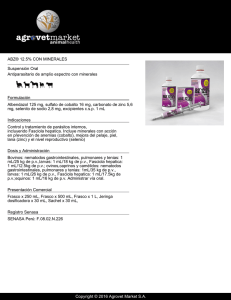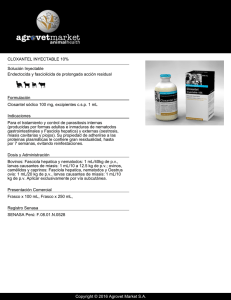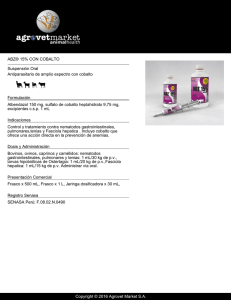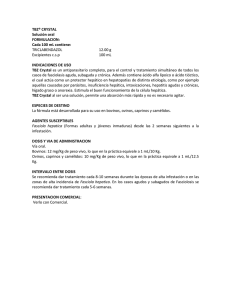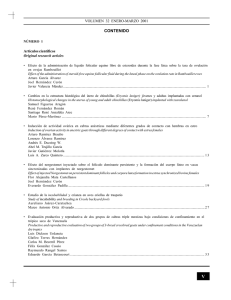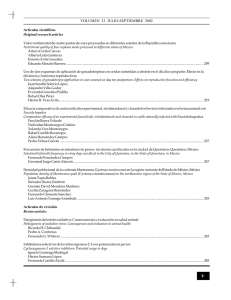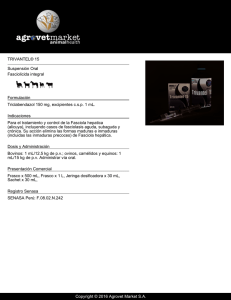rvm39407.pdf
Anuncio
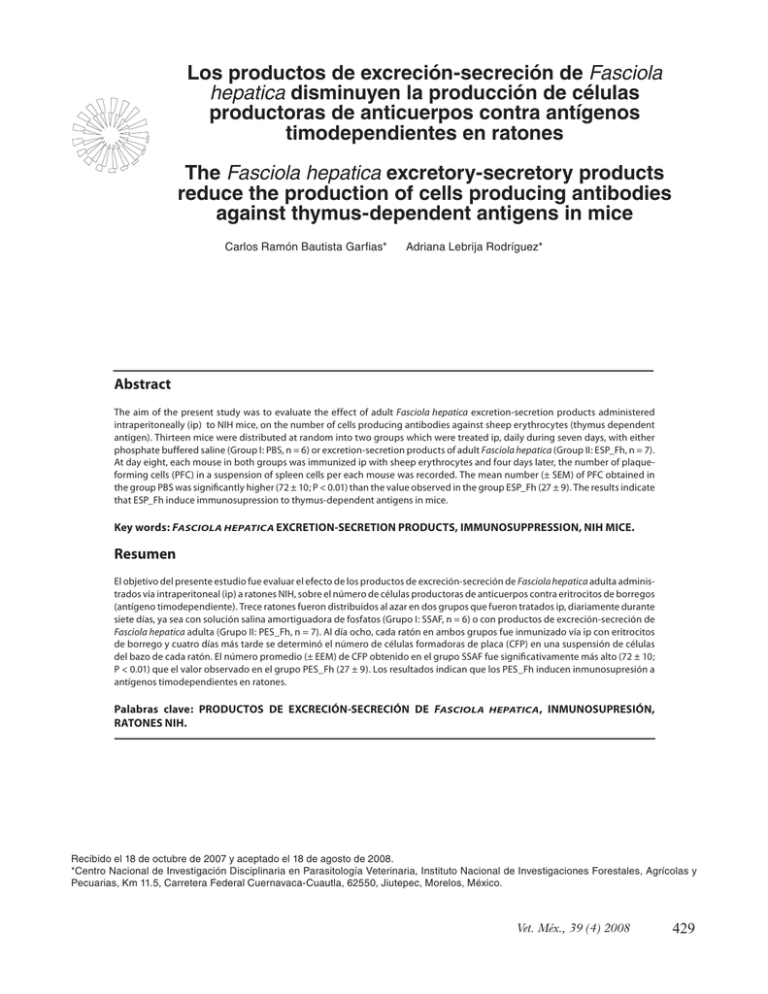
Los productos de excreción-secreción de Fasciola hepatica disminuyen la producción de células productoras de anticuerpos contra antígenos timodependientes en ratones The Fasciola hepatica excretory-secretory products reduce the production of cells producing antibodies against thymus-dependent antigens in mice Carlos Ramón Bautista Garfias* Adriana Lebrija Rodríguez* Abstract The aim of the present study was to evaluate the effect of adult Fasciola hepatica excretion-secretion products administered intraperitoneally (ip) to NIH mice, on the number of cells producing antibodies against sheep erythrocytes (thymus dependent antigen). Thirteen mice were distributed at random into two groups which were treated ip, daily during seven days, with either phosphate buffered saline (Group I: PBS, n = 6) or excretion-secretion products of adult Fasciola hepatica (Group II: ESP_Fh, n = 7). At day eight, each mouse in both groups was immunized ip with sheep erythrocytes and four days later, the number of plaqueforming cells (PFC) in a suspension of spleen cells per each mouse was recorded. The mean number (± SEM) of PFC obtained in the group PBS was significantly higher (72 ± 10; P < 0.01) than the value observed in the group ESP_Fh (27 ± 9). The results indicate that ESP_Fh induce immunosupression to thymus-dependent antigens in mice. Key words: FASCIOLA HEPATICA EXCRETION-SECRETION PRODUCTS, IMMUNOSUPPRESSION, NIH MICE. Resumen El objetivo del presente estudio fue evaluar el efecto de los productos de excreción-secreción de Fasciola hepatica adulta administrados vía intraperitoneal (ip) a ratones NIH, sobre el número de células productoras de anticuerpos contra eritrocitos de borregos (antígeno timodependiente). Trece ratones fueron distribuidos al azar en dos grupos que fueron tratados ip, diariamente durante siete días, ya sea con solución salina amortiguadora de fosfatos (Grupo I: SSAF, n = 6) o con productos de excreción-secreción de Fasciola hepatica adulta (Grupo II: PES_Fh, n = 7). Al día ocho, cada ratón en ambos grupos fue inmunizado vía ip con eritrocitos de borrego y cuatro días más tarde se determinó el número de células formadoras de placa (CFP) en una suspensión de células del bazo de cada ratón. El número promedio (± EEM) de CFP obtenido en el grupo SSAF fue significativamente más alto (72 ± 10; P < 0.01) que el valor observado en el grupo PES_Fh (27 ± 9). Los resultados indican que los PES_Fh inducen inmunosupresión a antígenos timodependientes en ratones. Palabras clave: PRODUCTOS DE EXCRECIÓN-SECRECIÓN DE FASCIOLA HEPATICA , INMUNOSUPRESIÓN, RATONES NIH. Recibido el 18 de octubre de 2007 y aceptado el 18 de agosto de 2008. *Centro Nacional de Investigación Disciplinaria en Parasitología Veterinaria, Instituto Nacional de Investigaciones Forestales, Agrícolas y Pecuarias, Km 11.5, Carretera Federal Cuernavaca-Cuautla, 62550, Jiutepec, Morelos, México. Vet. Méx., 39 (4) 2008 429 Introduction Introducción T la infección producida por el trematodo Fasciola hepatica en los ganados vacuno y ovino se le conoce como fasciolosis, enfermedad que provoca pérdidas anuales por dos mil millones de dólares.1 Este padecimiento, de importancia en seres humanos,2,3 puede incrementarse por los cambios climáticos (por ejemplo, el calentamiento global). El control de la fasciolosis se lleva a cabo principalmente por medio de antihelmínticos; sin embargo, el parásito ha desarrollado resistencia a éstos,4 por lo que se requiere de medidas alternas de control, entre éstas se ha propuesto el desarrollo de vacunas,5 para lo cual se requiere conocer la respuesta inmunitaria del portador contra el parásito, así como los mecanismos que utiliza el trematodo para evitarla. En este sentido, se ha demostrado que F. hepatica altera la respuesta inmunitaria de bovinos,6 ovinos7-9 y ratones.10-13 Con base en la utilidad que ha mostrado el uso de ratones para estudios de inmunología de la fasciolosis10-13 y en la relativa facilidad de ejecución de la prueba de células formadoras de placas hemolíticas (CFP),14,15 para la detección de células productoras de anticuerpos en la respuesta inmunitaria primaria, se decidió llevar a cabo el presente estudio, en el que se determinó el efecto de los productos de excreción-secreción de F. hepatica adulta (PES_Fh), inoculados en ratones NIH, sobre la producción de CFP a eritrocitos de borrego (antígeno timodependiente). he infection produced by the trematode Fasciola hepatica in cattle and sheep is known as fascioliasis, disease which it is estimated produces annual losses of two thousand million American dollars.1 Fascioliasis is also considered as an important zoonosis in human beings,2,3 and it can increase due to climatic changes (for example, global warming). The control of fascioliasis is carried out mainly by using anthelmintics; however, the parasite has developed resistance to them,4 for this reason alternative control measures are required, as for example the development of vaccines, 5 but for this there is the need to know the host immune response against the parasite, as well as the mechanisms that the trematode uses to avoid it. In this context, it has been demonstrated that F. hepatica alters the immune response of bovines,6 ovines,7-9 and mice.10-13 On the basis of the advantages shown by the use of mice in studies of fascioliasis immunology10-13 and in the easiness to carry out the technique of hemolytic plaque forming cells (HPFC)14,15 for the detection of antibody-forming cells in the primary immune response, it was decided to carry out the present study to evaluate the effect of excretion-secretion products from adult F. hepatica (PES_Fh), inoculated in NIH mice, on the production of HPFC to sheep erythrocytes (thymusdependent antigen). A Animals Animales NIH female mice, two to three months old, with an average weight of 20 g were used. They were allocated in plastic cages with sterilized sawdust under appropriate animal facility conditions. The animals were fed with commercial food and water ad libitum. En el estudio se usaron ratones NIH, hembras de dos y tres meses de edad, con peso promedio de 20 g. Luego, bajo condiciones adecuadas de bioterio, se alojaron en jaulas de acrílico con aserrín esterilizado y se les dio alimento comercial y agua ad libitum. Parasites Parásitos Complete adult Fasciola hepatica specimens were collected from parasitized bovine livers which were sacrificed at the abattoir, then the parasites were washed several times with sterile phosphate buffered saline solution (PBS) in accordance with Bautista and Morilla.16 Excretion-secretion products from adult F. hepatica (PES_Fh) Once the complete and clean flukes were obtained, the PES_Fh was prepared by using Hedon-Fleig solution, according to Bautista and Morilla.16 The protein content of the PES_Fh was determined by the Lowry et al. method.17 430 Se recolectaron ejemplares adultos íntegros de Fasciola hepatica a partir de hígados de bovinos con fasciolosis, sacrificados en el rastro, y luego se procedió a lavarlos varias veces con solución salina amortiguadora de fosfatos estéril (SSAF), de acuerdo con Bautista y Morilla.16 Productos de excreción-secreción de F. hepatica adulta (PES_Fh) Luego de recolectar las fasciolas adultas íntegras y limpias, se procedió a preparar los PES_Fh utilizando solución de Hedon-Fleig, según lo descrito por Bautista y Morilla.16 Al obtenerse los PES_Fh se determinó Sheep Erythrocytes (SE) el contenido de proteína por medio del método de Lowry et al.17 SE were collected in Alsever’s solution and kept at 4°C until used. Eritrocitos de borrego (EB) Determination of hemolytic plaque forming-cells (HPFC) Se recolectaron EB en solución de Alsever y se mantuvieron a 4°C hasta su uso. The method described by Cunningham and Szenberg15 was used. Briefly, with two side adhesive tape three areas of the same size were formed on a glass slide (75 × 25 mm). Then, three clean cover slips (22 square mm) were pressed on the tape to form three hollow chambers. Afterwards a mixture of spleen cells, complement (final Guinea pig serum dilution 1:10) and sheep erythrocytes (to an approximate final concentration of 4 × 10 8/mL) was prepared. Next, with a pipette the mixture was added to one side of the chambers which later were sealed with hot paraffin. It was allowed that cells settled in the chambers bottom by putting them in horizontal position to create a monolayer. Then, they were incubated at 37°C in a CO2 incubator during 45 minutes and then, with an optical microscope using the low resolution objective, the number of hemolytic plaques was assessed. Determinación de células formadoras de placas hemolíticas (CFP) Experimental design Thirteen NIH mice were allocated at random into two groups: those in Group I (n = 6) served as controls and received PBS by ip route daily during seven days. In Group II (n = 7) each mouse was inoculated daily during seven days by ip route with 100 µg of excretion-secretion products from adult Fasciola hepatica (PES_Fh). At eighth day, all mice from both groups were immunized by ip route with 0.2 mL of sheep erythrocytes at 10%. Four days after immunization, the mice were humanitarianly sacrificed to obtain the spleen, in order to prepare a cellular suspension in 199 medium to evaluate the number of hemolytic plaque forming cells (HPFC), in accordance with the Cunningham technique, which was carried out by triplicate/animal. Data obtained were analyzed by analysis of variance and when differences were found, the Tukey’s test was used.18 The results indicated that the treatment of mice with excretion-secretion products from adult Fasciola hepatica (PES_Fh) significantly lowered the number of HPFC in comparison with the control group treated with PBS (P < 0.01) (Figure 1). The mean HPFC number (+ SEM) was of 72 ± 10 for the group treated with PBS and of 27 ± 9 for the group treated with PES_Fh (Figure 1). At the same time, the results indicate that the PES_Fh lower the number of HPFC to thymus-dependent antigens in the primary immune Se siguió el método descrito por Cunningham y Szenberg.15 Brevemente se formaron tres áreas de igual tamaño sobre una laminilla de microscopio (75 × 25 mm) con cinta adhesiva de dos caras. Luego, tres cubreobjetos limpios (22 mm cuadrados) se presionaron firmemente sobre la cinta para formar tres cámaras huecas. Posteriormente se preparó una mezcla de las células del bazo junto con complemento (dilución final del suero de cuye 1:10) y eritrocitos de borrego (a concentración final aproximada de 4 × 108/mL). A continuación se adicionó la mezcla por medio de una pipeta por un lado de las cámaras que fueron luego selladas con parafina caliente. Se permitió que las células se asentaran en el fondo de las cámaras al colocarlas en posición horizontal para formar una monocapa. Enseguida se incubó a 37°C en una estufa de CO2 durante 45 minutos y luego se llevó a cabo la lectura para determinar el número de placas hemolíticas en un microscopio óptico compuesto usando el objetivo seco débil. Diseño experimental Trece ratones NIH fueron distribuidos al azar en dos grupos: los del Grupo I (n = 6) fungieron como testigo y recibieron SSAF por vía ip diariamente durante siete días. En el Grupo II (n = 7) cada ratón fue inoculado diariamente por siete días por vía ip con 100 µg de productos de excreción-secreción de Fasciola hepatica adulta (PES_Fh). En el octavo día todos los ratones de ambos grupos fueron inmunizados por vía ip con 0.2 mL de eritrocitos de borrego al 10%/ratón. Cuatro días después de la inmunización, los ratones fueron sacrificados humanitariamente para extraerles el bazo, con el fin de preparar una suspensión celular en medio 199 para determinar el número de células formadoras de placa (CFP), de acuerdo con la técnica de Cunningham,15 que se llevó a cabo por triplicado/ animal. Con los datos obtenidos se practicó un análisis de varianza y cuando hubo diferencias, éstas fueron sometidas a la prueba de Tukey.18 Los resultados indicaron que el tratamiento de ratones con productos de excreción-secreción de Fasciola hepatica adulta (PES_Fh) redujo significativamente el Vet. Méx., 39 (4) 2008 431 Number of plaque forming cells (2 × 106/mL) 100 90 80 70 Figura 1: Promedio (± EEM) de células formadoras de placa en una suspensión de células del bazo (2 × 106/mL) de ratones NIH tratados por vía intraperitoneal (T) con solución salina amortiguadora de fosfatos (SSAF) o con productos de excreción-secreción de Fasciola hepatica adulta (PES_ Fh), cuatro días después de la inmunización con eritrocitos de borrego (EB). Cada punto representa el promedio de seis a siete ratones (P < 0.01, prueba de Tukey). 60 50 40 30 20 10 0 0 1 2 3 4 5 6 7 8 9 10 11 12 13 14 Days response, in this case SE and they are consistent with the observation that the ip inoculation of an antigen from adult Fasciola hepatica suppresses the response to Bordetella pertussis (as well an thymus-dependent antigen); 11 similarly, sheep infected with F. hepatica have shown significant lower antibody responses to chicken erythrocytes as compared with non-infected control animals.8 In this context, studies carried out in mice indicate that the thioredoxin peroxidase contained in F. hepatica excretion-secretion products induces the alternative activation of macrophages, which contributes, among other causes, to the induction of Th213 responses and suppression of Th1 responses.12 Those observations and the ones obtained in this work suggest that the protective response induced by the ip inoculation of Freund’ s complete adjuvant in sheep, seven days before the infection with F. hepatica,19,20 generates a Th1 type response which influences such a protection. Taking into account the results of the present study it is concluded that the technique of HPFC was appropriate for demonstrating the immunosuppression induced by the PES_Fh in mice. Such a technique, besides being easy to carry out and cheap, it also can be used for studying the immune response to other parasitic infections in laboratory animals including sheep, on the basis that this test has been adapted for the evaluation of HPFC in lymphatic nodules and lymph of this animal species.21 Referencias 1. Spithill TW, Smooker PM, Sexton JL, Bozas E, Morrison CA, Creany J et al. Development of vaccines against Fasciola hepatica. In: Dalton JP, editor. Fasciolosis. Wallingford, United Kingdom: CAB International, 1999:377401. 2. Mas-Coma MS. Epidemiology of fascioliasis in human endemic areas. J Helminthol 2005;79:207-216. 3. Carrada-Bravo T. Fasciola hepatica: ciclo biológico y potencial biótico. Rev Mex Patol Clin 2007;54:21-27. 4. Mottier L, Alvarez L, Fairweather I, Lanusse C. Resis- 432 Figure 1: Mean number (± SEM) of plaque forming cells in a spleen cell 6 suspension (2 × 10 /mL) from NIH mice treated by intraperitoneal route (T) with phosphate buffered saline solution (PBS) or with excretion-secretion products from adult Fasciola hepatica (PES_Fh), four days after immunization with sheep erythrocytes (SE). Each point represents the mean of six to seven mice (P < 0.01, Tukey’s test). número de CFP en comparación con el grupo testigo tratado con SSAF (P < 0.01) (Figura 1). El número promedio (+ EEM) de CFPH fue de 72 ± 10 para el grupo tratado con SSAF y de 27 ± 9 para el grupo tratado con PES_Fh (Figura 1). Asimismo, los resultados señalan que los PES_Fh en ratones reducen la formación de CFP a antígenos timodependientes en la respuesta inmunitaria primaria, en este caso EB y son consistentes con la observación de que el tratamiento ip de ratones tratados con un antígeno de F. hepatica adulta suprime la respuesta contra Bordetella pertussis (también un antígeno timodependiente);11 similarmente, ovinos infectados con F. hepatica han presentado respuestas de anticuerpos significativamente más bajas a eritrocitos de pollo en comparación con testigos no infectados.8 En este sentido, estudios en ratones indican que la thioredoxin-peroxidasa contenida en los productos de excreción-secreción de F. hepatica induce la activación alterna de macrófagos, ello contribuye, entre otras causas, a que haya respuestas tipo Th213 y se supriman las respuestas tipo Th1.12 Esas observaciones y las obtenidas en el presente trabajo sugieren que la respuesta protectora inducida por la inoculación ip de adyuvante completo de Freund en ovinos, siete días antes de la infección con F. hepatica,19,20 genera una respuesta tipo Th1 que influye en dicha protección. De acuerdo con los resultados del presente trabajo, se concluye que la prueba de CFP resultó adecuada para demostrar la inmunosupresión inducida por los PES_Fh en ratones. Dicha técnica, además de sencilla y barata, también se puede utilizar para llevar a cabo estudios de la respuesta inmunitaria con otras infecciones parasitarias en modelos de laboratorio e inclusive en ovinos, puesto que la prueba se ha adaptado para la determinación de células formadoras de anticuerpos en nódulos linfáticos y linfa de esta especie.21 tance-induced changes in triclabendazole transport in Fasciola hepatica: ivermectin reversal effect. J Parasitol 2006;92:1355-1360. 5. Vercruysse J, Schetters TPM, Knox DP, Willadsen P, Claerebout E. Control of parasitic disease using vaccines: an answer to drug resistance? Rev Sci Tech Off Int Epiz 2007;26:105-115. 6. Flynn RB, Mannion C, Golden O, Hacariz O, Mulcahy G. Experimental Fasciola hepatica infection alters responses to tests used for diagnosis of bovine tuberculosis. Infect Immun 2007;75:1373-1381. 7. Arriaga C, Ruiz-Navarrete A, Gómez A, Fraire M, Bautista CR, Morilla A. Complejos inmunes circulantes en ovinos infestados con Fasciola hepatica. Rev Latinoam Microbiol 1987;29: 127-132. 8. Bautista Garfias CR, Orozco M, Morales E. Modulación de la respuesta de anticuerpos a eritrocitos de pollo en ovinos infectados experimentalmente con Fasciola hepatica. Rev Mex Parasitol 1988;1:14-18. 9. Prowse RK, Chaplin P, Robinson HC, Spithill TW. Fasciola hepatica cathepsin L suppresses sheep lymphocyte proliferation in vitro and modulates surface CD4 expression on human and ovine T cells. Parasite Immunol 2002;24:57-66. 10. Bautista Garfias CR, Garrido Pérez M. Efecto mitogénico de los antígenos somático y de excreciones/secreciones de Fasciola hepatica adulta en linfocitos normales de ratón BALB/c. Téc Pecu Méx 1995; 33:25-28. 11. Brady MT, O´Neill SM, Dalton JP, Mills KHG. Fasciola hepatica suppresses a protective Th1 response against Bordetella pertussis. Inf Imm 1999;67:5372-5378. 12. O’Neill SM, Brady MT, Callanan JJ, Mulcahy G, Joyce P, Mills KH et al. Fasciola hepatica infection downregulates Th1 responses in mice. Parasite Immunol 2000;22:147155. 13. Donnelly S, O’Neill SM, Sekiya M, Mulcahy G, Dalton JP. Thioredoxin peroxidase secreted by Fasciola hepatica induces the alternative activation of macrophages. Infect Immun 2005;73:166-173. 14. Cunningham AJ. A method of increased sensitivity for detecting single antibody-forming cells. Nature (Lond.) 1965;207:1106-1107. 15. Cunningham AJ, Szenberg A. Further improvements in the plaque technique for detecting single antibodyforming cells. Immunology 1968;14:599-601. 16. Bautista CR, Morilla A. Métodos de obtención de antígenos. En: Morilla A, Bautista CR, editores. Manual de Inmunología. México DF: Ed. DIana, 1986: 37-42. 17. Lowry OH, Rosebrough NJ, Farr AL, Randall RJ. Protein measurement with the Folin phenol reagent. J Biol Chem 1951;193:265-275. 18. Olivares Sáenz E. Paquete de diseños experimentales. Marín (NL) México. Facultad de Agronomía. Universidad Autónoma de Nuevo León, 1994. 19. Bautista Garfias CR, Gómez Arroyo A, Morilla González A, Vera Montenegro Y, Ibarra Velarde F. Inducción de resistencia inespecífica contra la infección por Fasciola hepatica en ovinos con adyuvante completo de Freund. Rev Mex Parasitol 1992;3: 1-3. 20. García Casanova L, Rodríguez Camarillo S, Bautista Garfias CR. Caracterización de la respuesta inmune humoral hacia antígenos de secreción/excreción de Fasciola hepatica en ovinos tratados con adyuvante completo de Freund. Téc Pecu Méx 1996; 34:136-145. 21. Cunningham AJ, Smith JB, Mercer EH. Antibody formation by single cells from lymph nodes and efferent lymph of sheep. J Exp Med 1966;124:701-714. Vet. Méx., 39 (4) 2008 433
